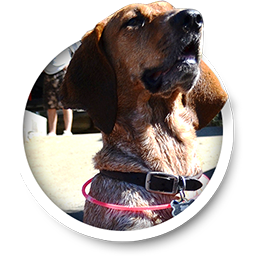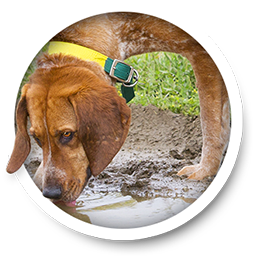Posted on 3/20/2015

Hi and welcome to Cayenne's automotive blog. That's right that's me in the photo, Cayenne! Today, let’s talk about the effect of tire tread depth on braking. When talking about stopping power, most Los Altos and Mt. View car owners tend to focus on our brakes. But our tires are where the rubber meets the road. So having good brakes isn’t enough. Safe Mt. View drivers need to have tires with enough traction to translate braking power into stopping power.
 Let’s focus on stopping in wet Mt. View conditions. In order for a tire to have good contact with the road, it has to move the water out of the way. If it can’t move the water, the tire will actually ride on top of a thin film of water.
Let’s focus on stopping in wet Mt. View conditions. In order for a tire to have good contact with the road, it has to move the water out of the way. If it can’t move the water, the tire will actually ride on top of a thin film of water.
That’s called hydroplaning. If it’s really bad, Mt. View motorists can actually spin out of control - endangering themselves and the other drivers around them. At best, you won’t stop as fast.
So how does a tire move water? It has channels for water to flow through. Look at your sedan tire and you’ll see channels: channels that run around the tire and channels that flow across the tire. They’re designed to direct water away from the tire so it can contact the road better.
And the deeper the channel, the more water it can move. A brand new Allied Auto Works tire has very deep channels and can easily move a lot of water. As the tire wears down, the channels become shallower and can move less water. When it wears down enough, it can seriously affect your ability to stop your sedan on wet Mt. View roads.
So that’s why it’s so important for CA drivers to replace their sedan tires when they get worn. Consumer Reports and other advocate groups call for a standard of 3/32 of an inch and they have the studies to prove it.
By comparison, you’ve probably seen the wear indicator that’s molded into tires. When tires are worn 3/32 of an inch, the tread wear bar is visible. So the recommended standard has twice the tread depth as a completely bald sedan tire.
At Allied Auto Works, we want our customers to know that the deeper recommended tread depth makes a big difference. Stopping distances are cut dramatically on wet Mt. View highway. A safe stop from CA freeway speeds with 4/32 of an inch of tread would result in a crash with worn out tires.
There’s an easy way to tell when a tire’s worn to 4/32 of an inch. Just insert a quarter into the tread. Put it in upside down. If the tread doesn’t cover George Washington’s hairline, it’s time to replace your sedan tires. With a Canadian quarter, the tread should cover the numbers in the year stamp.
Many Mt. View drivers have heard of this technique using a penny and Abe Lincoln’s head - the old method. That measure gives you 2/32 of an inch – half the suggested amount. Of course, sedan tires are a major purchase. Most of us in Mt. View want to get as many miles out of them as we can. But there’s a real safety trade-off. It’s your choice.
Big Wheels Keep On Turn'in ~ Cayenne
Posted on 3/10/2015

Hello, welcome to Allied Auto Works and my blog, Cayenne's Corner. Today's focus is batteries. It seems like everything in Los Altos runs on batteries. Of course, the batteries we’re most concerned with here at Allied Auto Works are those in our customer's vehicles. Just like the batteries in our smoke detectors or TV remote, car batteries wear out and need to be replaced. There are a couple of things Los Altos drivers should know when looking for a new battery.
Look for two measurements that come into play: cold cranking amps and reserve capacity.
Let’s start with cold cranking amps.  This can be thought of as the power output used to start a cold sedan engine. The number of cold cranking amps you need depends on your vehicle and where you live in CA, specifically how cold it is. (Many CA car owners have first-hand experience trying to start their car on a cold winter morning.) The two factors are that the colder your sedan's engine is, the more power it takes to turn the engine over to get it started. It has all that cold, sluggish oil to contend with.
This can be thought of as the power output used to start a cold sedan engine. The number of cold cranking amps you need depends on your vehicle and where you live in CA, specifically how cold it is. (Many CA car owners have first-hand experience trying to start their car on a cold winter morning.) The two factors are that the colder your sedan's engine is, the more power it takes to turn the engine over to get it started. It has all that cold, sluggish oil to contend with.
The other factor is that the chemical reaction in the battery that creates electrical energy is less efficient when the temperature dips. At Allied Auto Works, we consult the table shown below. Let’s say it’s eighty degrees Fahrenheit in Los Altos. At that temperature, 100% of the battery’s power is available. At freezing, only 65% of battery power is available, but it requires 155% as much power to start the engine as it did at eighty degrees.
As you can see from the chart, the colder it gets, more power’s needed, but the available power drops.
| Percent of Power Available | Celsius | Fahrenheit | Power Required | |
| 100 | 27 | 80 | 100 | |
| 65 | 0 | 32 | 155 | |
| 40 | -22 | 0 | 210 | |
| 25 | -32 | 20 | 350 | |
So if you live where it’s cold in CA, you need a battery with more cold cranking amps than you do where it's moderate or hot. The battery that originally came with your sedan was based on averages. At Allied Auto Works, we like to remind Los Altos drivers that they should always get at least as many cold cranking amps as their auto manufacturers recommend, but may want to upgrade if they live where it gets real cold.
And the type of engine you have will impact the battery you need: A six-cylinder engine requires more cold cranking amps than a four. An eight cylinder needs even more. And diesel sedans require more than a gasoline engine with the same number of cylinders.
Now on to reserve capacity: It’s a measurement of the number of minutes of reserve power the battery has at a given load. The number is more important to Los Altos auto owners these days because of parasitic drain. Parasitic drain is the battery energy that’s used when the key is off in your sedan. So, the power drawn by the security system, the remote start system, even the power the computers require to maintain their memory.
Reserves are also needed when you make very short trips around Los Altos. You’re not driving long enough for the battery to recover the energy it used to start the engine. So go with the minimum recommended by your manufacturer or Allied Auto Works and upgrade if you need more.
Talk with us at Allied Auto Works about your options. If you need more from your battery, a larger, heavy-duty battery may be called for. At Allied Auto Works in Los Altos, we remind our customers that it’s very important that the new battery fits your sedan: the terminals can’t be touching other parts.
Batteries are a big ticket item for most CA car owners, so the warranty gives piece of mind. There’re two kinds of car battery warranties: pro-rated and free replacement. With the pro-rated, you get a credit for a portion of the battery if it fails during the warranty period. With a free replacement warranty, you get just that, a free replacement. Be sure to ask us at Allied Auto Works about the warranty so you know what you’re getting.
Well I hope you got a charge out of today's lesson, Cayenne
Posted on 3/5/2015

Did you know that most of the cars driving around Los Altos, CA carry more computer power than the Apollo 121 Lunar Module that landed on the moon in 1969? Hi it's Cayenne again and let's see what we can learn today!
New cars sold in the Los Altos area have as many as twelve networked computers and over five miles (eight kilometers) of wiring. In fact, for the last decade or so, auto computers have been controlling about 85 percent of your vehicle's functions.
Cars have sensors for manifold air temperature, coolant temperature, manifold air pressure, airflow, throttle position, vehicle speed and oxygen content. All of this electronic wizardry is pretty complicated. So how do Los Altos motorists know when there is a problem?
It's simple; the Check Engine light comes on. The computer monitors all the sensors and uses that information to decide what to adjust such as the fuel mix, spark timing and idle speed. In addition, the computer monitors its own circuits. When it finds a fault, it turns on the Check Engine light and stores a trouble code in the computer.
It can be pretty disturbing for Los Altos drivers when the Check Engine light comes on. We wonder just how urgent it is. Generally speaking, it is not critical like a temperature or oil pressure light. When you get one of those it means STOP NOW! When the Check Engine light shows up, you should come in to Allied Auto Works in Los Altos to find out what the matter is as soon as possible.
Since 1996, there has been a strong emissions control component to the Check Engine diagnostic. But if your Check Engine light flashes on and off, you know that it is more urgent and you need to get it checked immediately to prevent damage. You should slow down and avoid towing or heavy loads until you can get it checked out.
Your personal and trust Allied Auto Works technician has special diagnostic equipment that will retrieve the trouble code from the computer and help him determine what is wrong. From there, we can fix it and get you back on the road.
Stop by if you're check engine light is on.
Allied Auto Works
2073 Grant Road & 1540 Miramonte Ave.
Los Altos, CA 94024
650.968.7227 (Grant) & 650.947.7228 (Miramonte)
Have a great day!
Cayenne